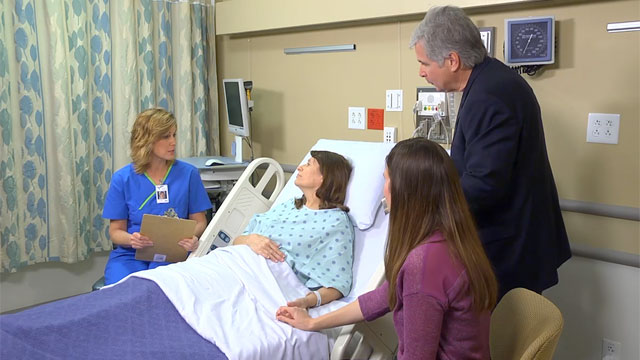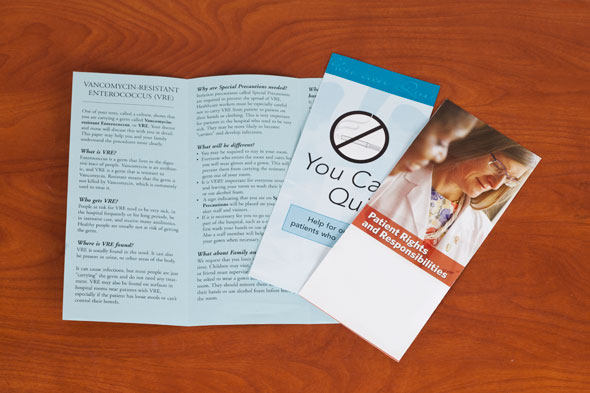Preoperative Nursing Care
Select a Skill:
- » Performing a Preoperative Assessment
- » Promoting Family Support and Participation
- » Teaching Postoperative Exercises
- » Preparing a Patient for Surgery
Take the Review Test:

Safety
- Help the patient through the process of preadmission testing (PAT), where a perianesthesia nurse, nurse practitioner, and sometimes the anesthesia provider interview the patient and/or family member, perform pertinent history and physical, diagnostic testing, consult if needed, as well as provide preoperative education to prepare the patient for surgery. Maintain confidentiality by observing the requirements of the Health Insurance Portability and Accountability Act (HIPAA).
- Observe privacy rules by ensuring that the patient agrees to the inclusion of family members in perioperative teaching and other sessions.
- Explain the importance of effective pain control, the risks associated with pain control, pain management (including safe use of patient-controlled analgesia), and alternative pain management strategies.
- Enlist the family’s or primary caregiver’s help with preoperative preparations such as quitting smoking at least 30 days before surgery, following a low-residue or clear liquid diet, or taking oral antibiotics.
- Educate the patient and/or family about any limitations the surgery may impose temporarily or permanently, and ensure that they have arranged for the resources they need to make the adjustment.
Equipment
(Roll cursor over items to see labels)

Patient education material (as appropriate)
Delegation
Do not delegate preoperative patient and family teaching to assistive personnel.
Preparation
- Identify the patient’s support system.
- Identify the person who will be the patient’s primary caregiver after discharge, and determine if additional assistance will be needed, such as from a home health agency.
- Evaluate the home environment for postoperative safety. For example, determine if stairs in the home will present a problem postoperatively and if the patient will have access to a shower or only to a bathtub for bathing.
- Assess learning needs, including the following:
- Cultural and religious beliefs
- Emotional barriers
- Desire to learn
- Physical or cognitive limitations
- Barriers to communication
- If needed, obtain a professional interpreter.
- Ask the patient to remove jewelry, such as a wedding ring, necklace, or items of clothing of personal significance, such as religious undergarments, if it is necessary to do so, and leave them with a family member.
- Assess the patient’s preferences for pain medication.
Follow-up
- Monitor the patient and family members for signs and symptoms of anxiety, and ask how they are feeling.
- Ask the patient and family members to repeat key information. Clarify any misconceptions.
- Answer any additional questions the patient or family members may have.
- Have the family identify the location of the waiting room.
- Observe the level of emotional support the family provides the patient.
- Observe the patient’s and family members’ coping strategies. Reinforce existing strategies, or suggest new ones.
- Ask the family if they can care for the patient at home after discharge.
- Contact the physician to discuss a home health care or extended care referral if the family cannot care for the patient at home.
Documentation
- Record preoperative teaching of the patient and family on the preoperative education flowsheet or other form, according to agency policy.
- Document your notification of the physician about the possible need for a home health care or extended care referral, if appropriate.
Review Questions
1. What is the primary purpose of promoting preoperative family participation?
 To prepare family members for the role of patient advocate
To prepare family members for the role of patient advocate To reduce the level of presurgical anxiety for family and patient
To reduce the level of presurgical anxiety for family and patient To identify important cultural factors influencing the patient's perception of health and healing
To identify important cultural factors influencing the patient's perception of health and healing To evaluate the family’s interest in and ability to provide postsurgical care and support to the patient
To evaluate the family’s interest in and ability to provide postsurgical care and support to the patient
2. How will the nurse ensure privacy when discussing a patient’s surgical needs with the family?
 Include the family in discussions only if the patient makes the request
Include the family in discussions only if the patient makes the request Discuss the patient’s right to privacy with all family members who wish to participate.
Discuss the patient’s right to privacy with all family members who wish to participate. Secure the patient’s permission to include family members in the presurgical counseling sessions
Secure the patient’s permission to include family members in the presurgical counseling sessions Reassure the patient that he or she will be consulted concerning any surgery-related decision.
Reassure the patient that he or she will be consulted concerning any surgery-related decision.
3. Which statement or question by the nurse illustrates the role of nursing assistive personnel (NAP) in providing preoperative instruction to the family of a patient scheduled for surgery?
 “Do the family members have any language barriers?”
“Do the family members have any language barriers?” “Let me know when the patient’s family is visiting with the patient.”
“Let me know when the patient’s family is visiting with the patient.” “Which family member seems to be the patient’s primary caregiver?”
“Which family member seems to be the patient’s primary caregiver?” “Please give the family a copy of the preoperative literature for cataract surgery.”
“Please give the family a copy of the preoperative literature for cataract surgery.”
4. The family of a surgical patient is concerned about being able to provide the care the patient will need after surgery. What is the nurse’s best response?
 “I’ll have social services look into the possibility of short-term rehabilitative care.”
“I’ll have social services look into the possibility of short-term rehabilitative care.” “Don’t worry—your father’s recovery should be relatively quick and his need for care minimal.”
“Don’t worry—your father’s recovery should be relatively quick and his need for care minimal.” “What do you see as being the problem your family has with providing the care he needs?”
“What do you see as being the problem your family has with providing the care he needs?” “Are you open to having a home health agency work with you to help provide care?”
“Are you open to having a home health agency work with you to help provide care?”
5. How can the nurse evaluate a family’s anxiety concerning its role in providing the patient’s postsurgical care?
 Observe the rapport among various family members and the patient.
Observe the rapport among various family members and the patient. Interview family members individually about their role in the patient’s recovery.
Interview family members individually about their role in the patient’s recovery. Ask the family to identify specific areas of concern.
Ask the family to identify specific areas of concern. Determine how much help the family will need.
Determine how much help the family will need.
You have completed the Review Questions for this skill. To take the Review again select the Start Over button. To proceed to another skill select from the dropdown menu. Select the Home or Back button to proceed to the next section.

